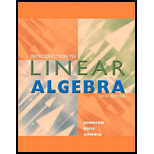
A sequence of orthogonal polynomials usually satisfies a three-term recurrence relation. For example, the Chebyshev polynomials are related by
Tn+1(x)=2xTn(x)−Tn−1(x), n=1,2,...,
where T0(x)=1 and T1(x)=x. Verify that the polynomials defined by the relation (R) above are indeed orthogonal in C[−1,1] with respect to the inner product in Exercise 28. Verify this as follows:
a) Make the change of variables x=cosθ, and use induction to show that Tk(cosθ)=coskθ, k=0,1,.... where Tk(x) is defined by (R).
b) Using part a), show that 〈Ti,Tj〉=0 when i≠j.
c) Use induction to show that Tk(x) is a polynomial of degree k, k=0,1,....
d) Use (R) to calculate T2,T3,T4, and T5.
28. An inner product on C[−1,1] is
〈f,g〉=2π∫1−1f(x)g(x)√1−x2dx.
Starting with the set {1,x,x2,x3,...}, use the Gram-Schmidt process to find polynomials T0(x),T1(x),T2(x), and T3(x) such that 〈Ti,Tj〉=0 when i≠j. These polynomials are called the Chebyshev polynomials of the first kind. [Hint: Make a change of variables x=cosθ.]
Want to see the full answer?
Check out a sample textbook solution
Chapter 5 Solutions
Introduction to Linear Algebra (Classic Version) (5th Edition) (Pearson Modern Classics for Advanced Mathematics Series)
- e). n! (n - 1)!arrow_forwardSuppose you flip a fair two-sided coin four times and record the result. a). List the sample space of this experiment. That is, list all possible outcomes that could occur when flipping a fair two-sided coin four total times. Assume the two sides of the coin are Heads (H) and Tails (T).arrow_forwarde). n! (n - 1)!arrow_forward
- Evaluate the following expression and show your work to support your calculations. a). 6! b). 4! 3!0! 7! c). 5!2! d). 5!2! e). n! (n - 1)!arrow_forwardAmy and Samiha have a hat that contains two playing cards, one ace and one king. They are playing a game where they randomly pick a card out of the hat four times, with replacement. Amy thinks that the probability of getting exactly two aces in four picks is equal to the probability of not getting exactly two aces in four picks. Samiha disagrees. She thinks that the probability of not getting exactly two aces is greater. The sample space of possible outcomes is listed below. A represents an ace, and K represents a king. Who is correct?arrow_forwardConsider the exponential function f(x) = 12x. Complete the sentences about the key features of the graph. The domain is all real numbers. The range is y> 0. The equation of the asymptote is y = 0 The y-intercept is 1arrow_forward
- The graph shows Alex's distance from home after biking for x hours. What is the average rate of change from -1 to 1 for the function? 4-2 о A. -2 О B. 2 О C. 1 O D. -1 ty 6 4 2 2 0 X 2 4arrow_forwardWrite 7. √49 using rational exponents. ○ A. 57 47 B. 7 O C. 47 ○ D. 74arrow_forwardCan you check If my short explantions make sense because I want to make sure that I describe this part accuratelyarrow_forward
 Linear Algebra: A Modern IntroductionAlgebraISBN:9781285463247Author:David PoolePublisher:Cengage LearningAlgebra & Trigonometry with Analytic GeometryAlgebraISBN:9781133382119Author:SwokowskiPublisher:Cengage
Linear Algebra: A Modern IntroductionAlgebraISBN:9781285463247Author:David PoolePublisher:Cengage LearningAlgebra & Trigonometry with Analytic GeometryAlgebraISBN:9781133382119Author:SwokowskiPublisher:Cengage Elements Of Modern AlgebraAlgebraISBN:9781285463230Author:Gilbert, Linda, JimmiePublisher:Cengage Learning,
Elements Of Modern AlgebraAlgebraISBN:9781285463230Author:Gilbert, Linda, JimmiePublisher:Cengage Learning, Elementary Linear Algebra (MindTap Course List)AlgebraISBN:9781305658004Author:Ron LarsonPublisher:Cengage Learning
Elementary Linear Algebra (MindTap Course List)AlgebraISBN:9781305658004Author:Ron LarsonPublisher:Cengage Learning



